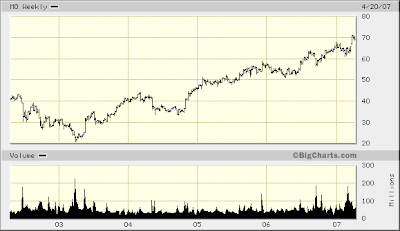The Philip Morris USA unit of Altria Group (MO) has decided to launch a smokeless product under the Marlboro name. In some corners this is being called “a substantial risk”. Not only is it not a risk, it is the closest thing to a slam dunk. Here is why.
Almost forty percent of the cigarettes sold in the U.S. are Marlboros. In order to truly appreciate the dominance Marlboro has on the industry, one had to consider #2, is only at 6%!! Now you also have to consider that it has been this way for almost 1/2 a century.
Let’s talk about smokers. There isn’t a more brand loyal lot out there than tobacco users, except for possibly scotch drinkers. Having both smoked and chewed (many years ago), I am speaking from experience. If you smoke or chew a brand, that is your brand, period, end of story. Only under the most extreme circumstances will you switch and it is doesn’t have anything to do with price, it has to do only with availability. If you cannot get your brand, you will use another and that is the only reason. This is the why Altria has been the single best investment in the history of the US stock market.
Now the new product. Smoking rates have decreased steadily for some time now while smokeless tobacco use is increasing 3%-4% a year and up until this point, Altria has not been in this market. The new product can be used in offices and restaurants since it does not violate any of the smoking bans enacted in recent years and it is not “wet” like other forms of smokeless tobacco so users do not have to spit juice. In April I posted about the product not then labeled under the Marlboro brand name and now that it is, I am more excited that ever. Chew users will gravitate to this brand as they can use it anywhere and not have to carry a plastic Coca Cola bottle around filled with spit. But that is not the best part. The kicker is: Since it is a dry product, smokers will use it when they are inside and do not want to have to go to the “smoking area” and be looked down upon like lepers. They can now sit at their desk’s and get their fix, no one will be any wiser and there will be no lost work time. There will also be the added bonus of not smelling like an ashtray all day (it’s the little things). What does all this mean? More tobacco sales for Altria. Simply put, you have the number one brand of tobacco giving it’s users the ability to now use their product in places they now cannot. Perhaps this is why the tag line “Flavor Anytime” is being tossed around. Ka-Ching..
So let’s address the elephant in the room. Cancer. Snus is widely used in Scandinavia, where numerous studies proved that it offers smokers an alternative way to get the nicotine and taste of cigarettes with less risk of cancer. A safer product that can be used everywhere smoking is banned and is spit free. Where is the problem?
Investing morality. When god created man he did so in his own image. This means he gave us “free will”. We are free to drink, smoke, gamble, eat lousy foods, drive like a-holes and smash our hands with hammers so should we choose to. Now there may be ramifications to any of those actions, but we are free to do them. Folks are free to smoke and I choose to watch my kid’s college funds grow from it, guilt free. I stopped, so can they.
Ignoring a great investment on moral grounds is just foolish. Profit from it and do something good with the money if you are so inclined. You will never stop smokers by not buying Altria shares. If you do buy them and profit you may actually be able to stop young smokers by funding programs at local schools. Avoiding shares because they “sell tobacco” is just putting your head in the sand and plain stupid. Poverty never cured society or it’s ills, wealth has cured plenty.
Will it sell? Will Apple (APPL) fans buy iPhones (they would buy a hell of a lot more at a reasonable price)? Will Diageo’s (DEO) Johnny Walker Black users buy Blue? Will Star Wars fans line up around the block for the next installment?
Need I go on?????



